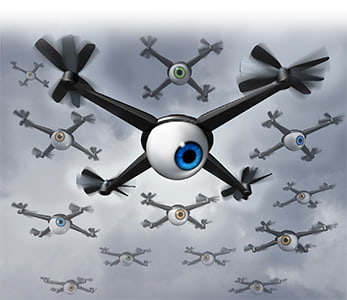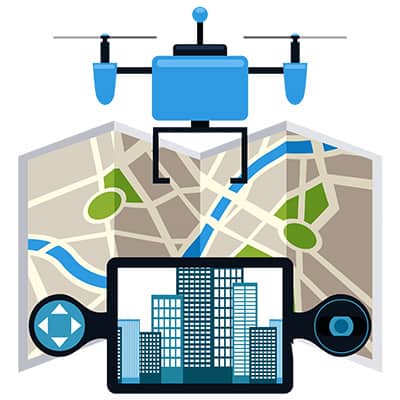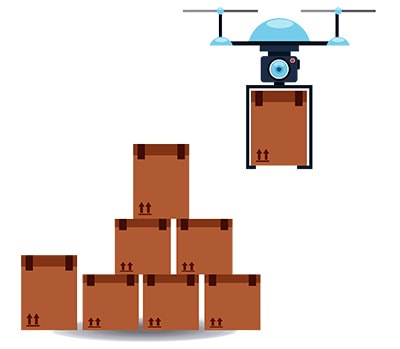Drone Laws and Regulations in UAE
 With new innovations and big investments, drone technology continues to evolve almost every day, bringing more advanced drones to the market every few months. Almost every week we see press releases and research papers on the use of drones in new areas and industries. The popularity of drones has grown over the years, and new models release every day with the addition of newer and more complex technology. Drones or Unmanned Aerial Vehicles (UAV) include everything from the drone’s aerodynamics, materials used in the manufacture of the UAV, the chipset, circuit boards and software used in the drone.
With new innovations and big investments, drone technology continues to evolve almost every day, bringing more advanced drones to the market every few months. Almost every week we see press releases and research papers on the use of drones in new areas and industries. The popularity of drones has grown over the years, and new models release every day with the addition of newer and more complex technology. Drones or Unmanned Aerial Vehicles (UAV) include everything from the drone’s aerodynamics, materials used in the manufacture of the UAV, the chipset, circuit boards and software used in the drone.
What are Drones?
Drones or an Unmanned Aerial Vehicle is an aircraft that can be navigated via control from the ground using a GPS tracking system, that is without a human pilot on board the aerial vehicle. In simple terms, they are aerial vehicles that do not require a human to pilot it from within. Drones can range from those tailored for beginners to those for skilled projects. Some drones come with a memory card that allows the user to record footage and upload it to their computer. The navigation of the drones is via their channel control and transmitter; the user can better navigate the drone at a higher speed with higher channels of control.
- Types of Drones
Drones can be classified on different bases- such as on the basis of size, or on the basis of use like drones for photography, aerial mapping, surveillance, etc. However, the most significant classification of drones that is on the basis of aerial platforms, there are 4 types of drones:
- Multi Rotor Drones
These are the most common types of drones used, both by professionals and hobbyists alike. Used for most common applications like aerial video surveillance and aerial photography, it also offers wide variants for the purposes of leisure like amateur drone racing. This type of drone is the easiest to manufacture, the cheapest one available in the market, and has 4 variants depending on the number of rotors: Tricopter (3 rotors), Quadcopter (4 rotors), Hexacopter (6 rotors) and Octocopter (8 rotors).
- Fixed-Wing Drones
These drones use a wing similar to normal airplanes and unlike the non-fixed-wing type models, does not utilize energy to stay afloat on air. These drones cost more and require more skill-set for operation.
- Single Rotor Helicopter
They look very similar in design and structure to helicopters and unlike a multi-rotor drone, only have one big-sized rotor with a small-sized one on its tail to control its heading. They are much more efficient than the multi-rotor drones and have higher flying times but also require a higher skill-set and training to operate.
- Fixed Wing Hybrid VTOL
Being a hybrid, these drones combine the benefits of higher-flying time of fixed-wing models with the hover function of the rotor-based models. Though there wasn’t much success in its testing since the 1960s, with the development of new generation sensors like gyros and accelerometers, the concept received a new life.
- Use of Drones
Many sectors where the usage of drones have been introduced to, previously used helicopters and airplanes to achieve the tasks. This was not a viable option since helicopters and airplanes are expensive to hire and are sometimes not available when most required.
There are so many uses of drones in all specters of life today including drone light concerts synchronized to the music, however, for reference, some of them are listed below:
- Search and Rescue- Drones are used more in mission-critical sectors. Departments like fire departments, lifeguards, first responders, mountain rescue teams have become big users of drones since it assists in finding and rescuing people as fast as possible.
- Marketing- marketing and advertisement form an essential component of businesses nowadays. Drones such as DJI inspire 1 are useful in producing professional quality aerial films and still photos cost effectively, helping the creation of professional marketing material.
- Site Surveying- the use of drones in surveying has saved a lot of time by avoiding the need to build scaffolding to survey a building or structure. More importantly, it also saves the employees from taking on the responsibility of doing dangerous work.
- Parcel Deliveries- Constantly in the news, drones are increasingly being used to deliver parcels including pizzas. Amazon even initiated a Prime Air Delivery Project to deliver the orders. Many big postal companies across Europe and Asia are testing out package delivery using drones. SF Express, China’s largest package carrier was granted the first of its kind license in China on April 2018 to use drones to deliver packages by the Civil Aviation Administration of China (CAAC).
- Use in Agriculture and Environment Conservation- Farmers use drones on farms, from livestock to crops and vines, providing data like soil fertility, detect deficiencies, identify pests, diseases and weeds. Researchers in Japan have created small insect-sized drones to pollinate plants which will help with indoor pollination, mimicking the duty of honeybees.
UAE Regulations and Laws on the use of Drones
 Like any other flying objects, UAVs are also prone to accidents, causing damages to external properties, attached cameras, instruments, as well as to the body. Like any new technology, misuse or accidents can result in huge damages and liabilities to third parties for property damage, bodily injuries or interruptions.
Like any other flying objects, UAVs are also prone to accidents, causing damages to external properties, attached cameras, instruments, as well as to the body. Like any new technology, misuse or accidents can result in huge damages and liabilities to third parties for property damage, bodily injuries or interruptions.
There have also been incidents where UAVs have flown into restricted or unauthorized areas causing serious security concerns to the authorities. For instance, a drone caused disruption at the Dubai Airport on October 29, 2016, by entering its airspace. The Dubai Airport, as a result, had to be closed for more than an hour which subsequently caused 22 flights to be diverted. Drones are thus prohibited within a 5km radius of all UAE airports.
To ensure that the increased use of drones does not negatively impact airspace/cyber safety or security or privacy, the use of drones in the UAE are subject to strict regulations by the UAE government.
The foundation for the present legal framework was laid by the Federal Resolution No 2 of 2015-Regarding Light Air Sports Practice Regulations which set out requirements relating to the use of drones.
- UAE General Civil Aviation Authority (GCCA)
The UAE General Civil Aviation Authority (the GCAA) is the regulatory authority for the use of drones in the UAE, building on the foundations already laid down by the Federal Resolution No 2 of 2015. The GCAA published the GCAA Civil Aviation Regulations (the Regulations) which establishes the rules and guidelines for the use of drones in the UAE.
Drones fall within the purview of the definition of an Unmanned Aerial System (a UAS) by the Regulations, which states, a UAS is “an aircraft and its associated elements which are operated with no pilot on board”.
- No Fly Zone- the GCAA has an app “UAE Drone Fly Zone Map” which allows drone users to ascertain the designated areas in UAE for the operation of drones in UAE.
- Classification
The Regulations also separate UAE into six categories based on physical and operational parameters:
- Category 1- drones weighing less than 5 kgs
- Category 2- drones weighing between 5kgs and 25kgs
- Category 3- drones weighing more than 25 kgs
- Each category has subcategories for commercial and private use.
Private and Commercial Users:
Users of UAS for private leisure and sport are termed as private users, while commercial users use drones for purposes such as media, surveying, surveillance, inspection, air delivery amongst others.
- Regulation Requirements
There are minimum operational requirements and restrictions for each category. For example, private users in Category 1, 2 and 3 are prohibited from using drones with video or image capturing devices, while commercial drones in these categories may use drones with cameras or similar devices but require prior approval from the GCAA.
- For an Organization/Operator (Commercial or Non-Commercial)
All drones in excess of 250 grams need to be registered using the registration platform hosted on the Emirates Standards and Metrology Authority (ESMA) website. A registered drone will be provided with an ESMA certificate, which will also carry a unique serial number and geo-fencing microchip to allow the drone to be tracked by the authorities.
Regulations require that any drones used for commercial or non-commercial uses, other than for recreational purposes, are required to obtain a UAE Operator Authorization (UOA) which is issued for a period of 1 year. It involves the following documentation and processes:
- Obtain security clearance for the organization through the GCCA website.
- An application letter (in company letterhead) signed by an authorized representative is to be submitted to drones@gcaa.gov.ae with the following details:
- List of the unmanned aircraft type with serial number, color and mass in KG
- Management Commitment Statement
- Description of the proposed operation
- Subscription to GCAA E-publication through GCAA website.
- Compulsory Insurance: The UAE in 2017, announced compulsory minimum insurance requirements for drones in commercial use and imposed a minimum liability of AED 3.67 million. In October 2017, the UAE announced mandatory minimum insurance requirements for commercially operated drones. These requirements impose minimum liability coverage of AED3.67 million. It has also been announced that mandatory insurance will be required for privately operated drones in 2018.
- For an Individual/Private User (Recreational)
- User and drone should be registered with the GCCA before flying
- Only drones weighing 5kgs or less shall be allowed to fly in the approved zones for flying, that is the green zone.
- The drone shall not use any video or image capturing devices; be equipped with the drop or release devices.
- Shall fly only during day-time in good weather and its flying range should always be within the line-of-sight. It shall not fly more than 400 feet above ground level.
- The drone cannot be used for commercial activities
- The responsibility is on the user to ensure that the drone is used in accordance with the manufacturer’s instructions and is inspected before use.
- No user shall fly the drone:
- The minimum age of 21 years is required for a user to fly a drone weighing more than 25 kgs.
- The drones weighing above 5kgs or those equipped with a gas engine shall only operate within GCAA approved flying clubs.
- The user shall immediately report any accidents/incidents to the GCAA and responsible to inform the GCAA about his intentions to sell the drone.
- The user shall avoid collisions with people, objects, other manned and unmanned aircraft as well as not harass or endanger people or threaten to damage property.
- There shall be a direct radio control link between the user and the drones and shall maintain the Frequency Band Restrictions, considering the effects on radio communication, interference of the frequency used;
- Within 5km of the UAE airports’ outer fence, heliports, helicopter landing sites, and airfields, or in controlled zones.
- Near the public or private property
- Sanctions
- Article 69 prescribes imprisonment of 1year and/or a fine not exceeding fifty-thousand Dirhams if:
The owner or operators cause the drone to be flown without an authorization or permit from the competent authority or after the expiry or revocation of such certificates; or pilots it when drunk enough to impair his capacity to pilot; caused damage to aeronautical communication facilities or navigation aids or not maintained such facilities in good condition; or does not enter the required information in the documents or records of the aircraft or altered the information.
- Article 70
A term of imprisonment not exceeding three years and/or fine not exceeding one-hundred thousand Dirhams to any person who uses a drone without registration marks or displays a wrong one; flew the drone in a prohibited area; not complied with the order to land the drone along with similar other offenses.
- Rules Regarding Drone Photography
 Article 378 of the UAE Penal Code clarifies that taking pictures of someone without their consent or in legally permitted circumstances shall be an invasion into the privacy or family life of an individual which will lead to the confiscation and destruction of the recordings and the photographer or videographer may be fined or imprisoned. Anyone who publishes such a picture or video shall be liable to the same punishment.
Article 378 of the UAE Penal Code clarifies that taking pictures of someone without their consent or in legally permitted circumstances shall be an invasion into the privacy or family life of an individual which will lead to the confiscation and destruction of the recordings and the photographer or videographer may be fined or imprisoned. Anyone who publishes such a picture or video shall be liable to the same punishment.
Article 43 of the UAE Copyright Law grants certain exceptions to Article 378- if the photographer or videographer captures a picture of another they shall not have the right to keep, show, sell, exhibit, publish, communicate, distribute the pictures without the prior consent of the person concerned. The punishment for the offense under this article is detention for a period not exceeding 6 months and a payment of a fine.
 English
English
 عربي
عربي Русский
Русский 官话
官话 português
português
 Türk
Türk 









